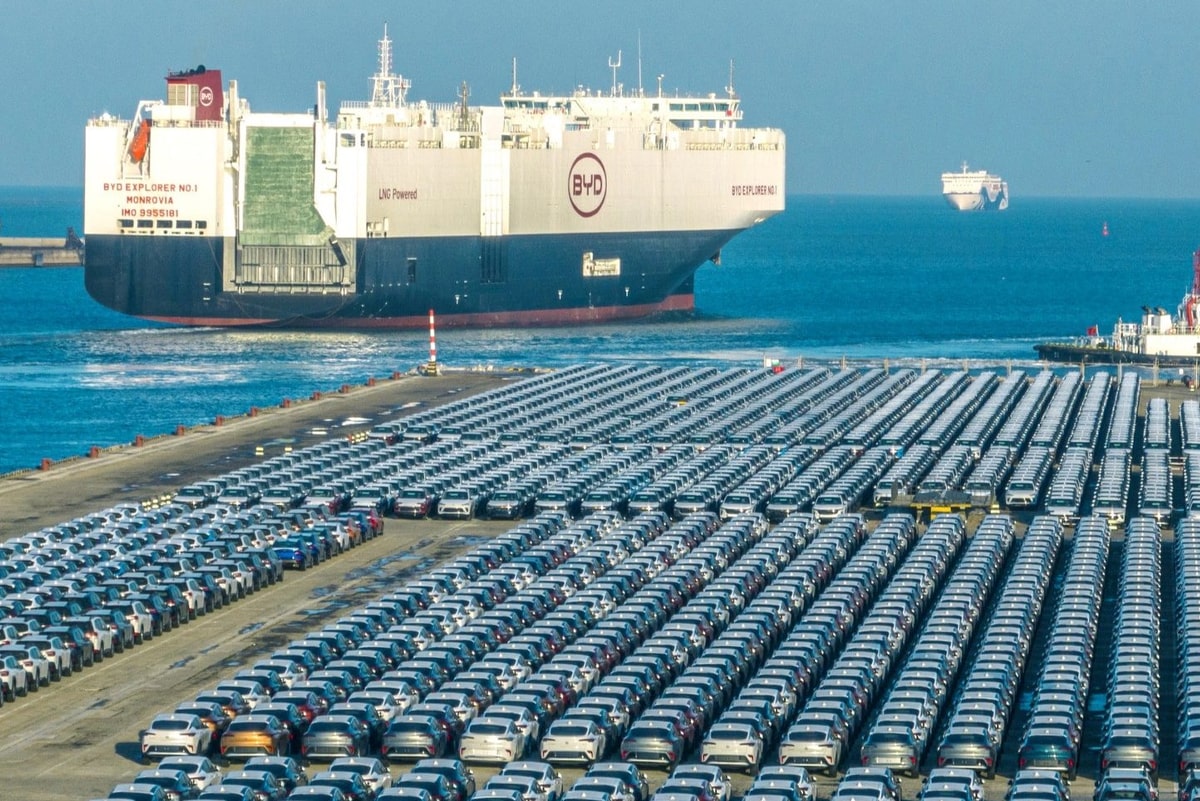
What effect do punitive tariffs have on EVs from China? Ten questions for Peter Mock, ICCT
Last week, the EU Commission sent the proverbial final warning to the government in Beijing in the months-long proceedings surrounding Chinese electric cars. In essence, it sounds like this: Either there is an agreement by the beginning of July – or we will demand punitive tariffs from then on.
So far, EVs from Chinese manufacturers only have a small market share in Europe, but it doesn’t have to stay that way. The EU accuses China of subsidising its EVs along the entire value chain – from the extraction of raw materials to production and transport to Europe. In total, Chinese manufacturers could offer their EVs up to 20 per cent cheaper due to this competitive advantage, according to the EU. As state-owned manufacturers such as SAIC, in particular, benefit from the subsidies, they will be subject to significantly higher punitive tariffs than the private-sector company BYD, for example.
Regardless of whether an agreement is reached with Beijing or punitive import duties are imposed, the matter will not leave the car industry and especially the EV market unscathed. We spoke to Peter Mock from the ICCT about the possible consequences. Here is the interview:
Mr Mock, the EU wants to impose tariffs on Chinese car manufacturers. SAIC, with its affordable MG models, will be particularly affected. However, EVs from German manufacturers would also be affected. For example, BMW only builds the iX3 in China. What does that mean for the market growth of EVs in Germany if tariffs are really imposed?
The market share of battery-powered cars has remained relatively constant at around 13 per cent since the beginning of the year. It was foreseeable that 2024 would not be a good year for EVs. All vehicle manufacturers are currently comfortably meeting their CO2 targets, which have remained virtually unchanged since 2020. Stricter target values will only apply from 2025. Unfortunately, the EU regulation provides for these five-year stages instead of setting continuously decreasing target values each year. As a result, manufacturers have no incentive to sell even one more EV this year than last year. However, this will change abruptly from January 2025, when manufacturers will (once again) use creative marketing campaigns to attract EV buyers. And just as the EV share suddenly skyrocketed from 2019 to 2020, market growth will increase significantly again in 2025 – with or without tariffs.
Many Chinese brands are currently in the starting blocks in Europe. However, in Bremerhaven, Germany, EVs from the Far East are already starting to rust. How does that fit together?
In addition to the current restrained marketing interest on the part of the manufacturers, there are two other obstacles: deep uncertainty among German customers and the still relatively high price level of EVs in Europe. On the latter point, the Chinese brands have a clear advantage. While German manufacturers have long focussed solely on the premium segment, Chinese brands already offer smaller vehicles at attractive prices. So far, these have been advertised at significantly higher prices in Europe than in the Chinese home market. However, prices for vehicles from Asia could drop quickly. In turn, favourable prices would also increase demand from customers. Even if we sometimes forget it, the electrification of the vehicle fleet in Europe represents a huge growth market. If some production is now being stockpiled for a few months, in retrospect, this situation will remain a side note in history.
In Germany, we usually talk in general terms about “Chinese manufacturers.” However, the EU Commission wants to differentiate between individual manufacturers regarding special tariffs. How do you assess this plan? Does it affect “the right people,” or is it more of an unrealistic categorisation by politicians in Brussels?
Sometimes, it is not easy to put a stamp of origin on a manufacturer. A good example is the Smart brand. Initially part of Mercedes-Benz, one would think it was a German brand. However, the brand is now owned equally by Geely and Mercedes-Benz. Not a single Smart model is produced in Europe any more; the vehicles all come from China. According to the EU Commission’s plans, a duty of 21 per cent would be levied on Smart cars. Other models from supposedly German manufacturers would also be similarly affected. That shows how quickly the special tariffs under discussion can fall on the feet of the domestic industry itself.
German manufacturers, in particular, fear for their (still strong) business in China. Who will ultimately suffer more from a potential trade war in the automotive sector?
The main losers will be the customers. That is because tariffs make vehicle prices more expensive, making EVs less affordable than they would be with free trade. However, German manufacturers will also lose out in two ways. Firstly, their models produced in China, such as the BMW iX3, will be subject to import duties in the EU, which will impede sales of EVs from German manufacturers in Europe. At the same time, the Chinese government will most likely respond with countermeasures and penalise vehicles with combustion engines produced in Germany with import duties. As a result, sales of profitable combustion engines in China will fall even faster than is already the case. Meanwhile, Chinese manufacturers can cushion the impact of EU import duties, at least temporarily, through lower production costs and thus gain market share.
China cannot sell off its electric cars in the US (100 per cent punitive tariffs), and it is becoming more difficult in Europe, depending on the brand. Which markets could China’s electric cars go to instead? Or will China even have to reduce its electric car production capacities?
Tariffs can divert market flows in the short term. In the longer term, however, what counts most is the potential of a new technology. EVs offer many advantages over conventional vehicles with combustion engines.
Therefore, we need more rather than less production capacity in the medium and long term. Chinese manufacturers will use an enforced breather in the global electrification race to reorganise their production and create more local production capacity, for example. Their strong role as a global EV exporter will not suffer in the long term.
In 1980, Europe was worried about cars from Japan flooding the market. A decade later, the South Koreans came. By the end of 2023, Chinese brands had a market share of just three per cent in Germany. So, is the threat to German and European car manufacturers really that great? And what can we learn from 1980?
Back then, the oil price crisis was the dominant issue. Japanese manufacturers had small, fuel-efficient models on offer. At the same time, it was an innovative way of production, hand in hand with trade unions and the principle of “lean production,” which made lower prices possible. Customers increasingly opted for Japanese-made models, which was seen as a threat to Germany’s industry. Punitive tariffs followed. Today, we are affected by climate change. Chinese manufacturers offer attractive EVs and can achieve lower costs through integrative production models instead of excessive outsourcing. Tariffs are once again on the agenda. Japanese manufacturers have long been an integral part of production in Europe, with local factories and a market share that has levelled off at around eight per cent. The punitive tariffs that were initially imposed have been reduced again. Incidentally, the entry of Japanese and later South Korean manufacturers has not harmed German manufacturers. Their market share today remains relatively constant at around 50 per cent, as it was 50 years ago.
The Japanese and South Koreans now build some of their models in Europe. From China, only BYD has announced an EV factory in Hungary. How likely is it that most Chinese manufacturers will produce EVs in Europe?
BYD announced at the beginning of May that it is considering a second factory in Europe. At the same time, contract manufacturers, such as the Austrian Magna Steyr plant, are currently being bombarded with enquiries from Chinese brands. It is foreseeable that Chinese manufacturers will increasingly push for local production in Europe. However, such a switch in production could also be achieved by imposing minimum requirements on manufacturers, similar to what China has been doing for years by forcing foreign brands into joint ventures. It would not necessarily require punitive tariffs.
Do you expect the EU and China to reach an agreement by 4 July and avert the punitive tariffs, and if so, what form could such an agreement take?
That is now in the hands of high politics, and I wouldn’t dare to make a prediction. Perhaps we could think more in terms of minimum requirements for the locally produced share of a vehicle instead of insisting on the concept of punitive tariffs.
Is this the result of Europeans neglecting electric mobility for so long?
Definitely. European and, above all, German manufacturers have rested on their supposed superiority in combustion engines for far too long. Even before the Dieselgate scandal, it was clear that this arrogance was a mistake. Not long ago, German and Chinese manufacturers set out from the same starting point towards increasing electrification. Chinese manufacturers have been on a 100 per cent EV path ever since. On the other hand, German manufacturers ignited one flash in the pan after another, starting with “clean diesel” and moving on to mild hybrids, plug-in hybrids and e-fuels. This zigzag course and supposed openness to technology is slowing down and making the turnaround in drive technology more expensive.
And how does the political demand to abolish the EU combustion engine ban in 2035 fit into this world? Or was this just an election campaign hit for German conservative parties, which has now been silenced and will only be repeated if necessary at the general election?
The 2035 target is in itself completely technology-neutral. Vehicle manufacturers have long since adjusted to this target and adapted their product strategy. Every new change, of course, destroys investments already made by manufacturers and causes further uncertainty among customers. Not to mention that changing existing legislation is lengthy and that companies lack planning and investment security. Vehicle manufacturers need precisely the opposite: planning security for CO2 fleet targets, positive communication of EVs to customers, and a more CO2-based vehicle tax system that gives them a tailwind for EV sales in Germany. Ultimately, the drive revolution cannot be stopped: The good old Nokia 3310 model can now only be found in museums – punitive tariffs on smartphones could not have prevented this. What counts is the technology’s potential.





1 Comment